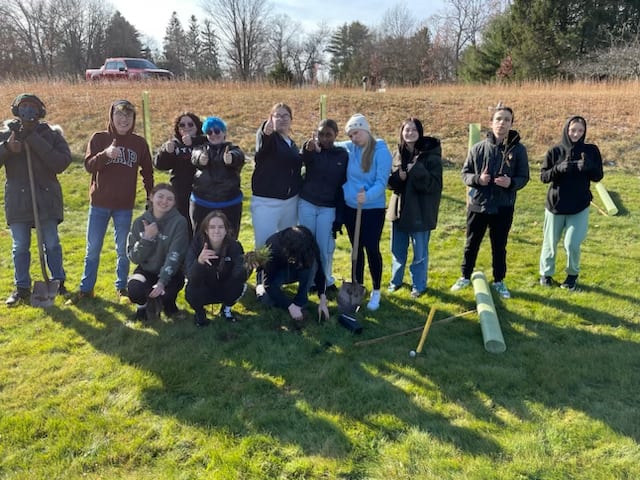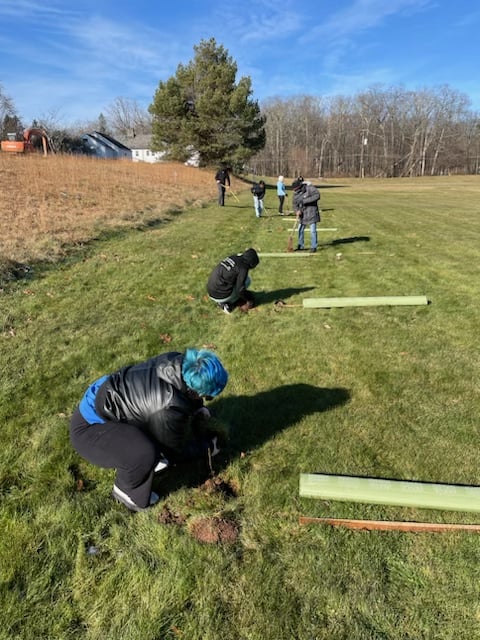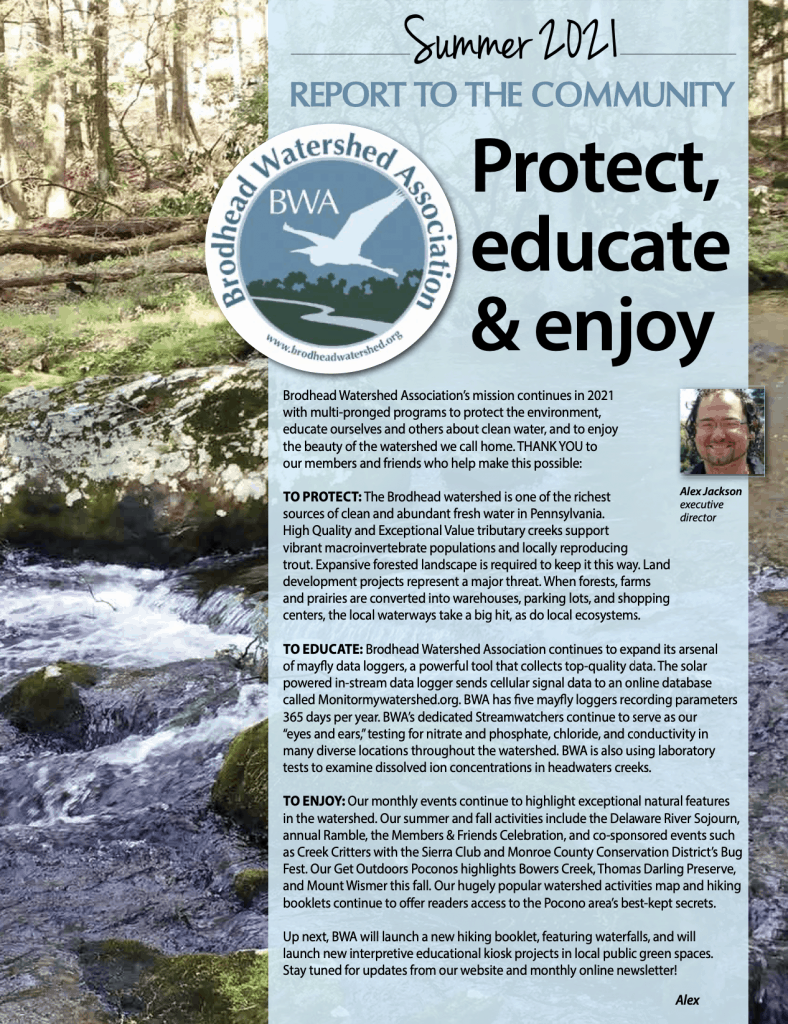GREENING MOUNTAINHOME
The Greening Mountainhome project is a Green Communities project funded by grants from the National Fish and Wildlife Foundation, with support from The William Penn Foundation, and the Weiler Family Foundation. Green projects in Mountainhome and surrounding areas will help keep Mill Creek cold and clean. Read more about Mill Creek here.
More planting of trees and shrubs in 2023
As a spin-off from the October planting at Mill Creek, the Evergreen School Senior class planted 60 native trees and shrubs at the new Barrett Administration Recreation Center (BARC), another 60 trees were planted in the headwaters of Buck Hill Creek by members of the Buck Hill Conservation Foundation and members of Brodhead Trout Unlimited planted 50 trees and shrubs along Cherry Creek.
Streambank Planting 2023
Saturday October 7 was a soggy day, but a little rain didn’t deter scouts and leaders of Troop 89 from accomplishing their mission! 250 native trees and shrubs were planted along Mill Creek in Barrett Township to ensure that Mill Creek remains one of the cleanest streams in the Poconos.
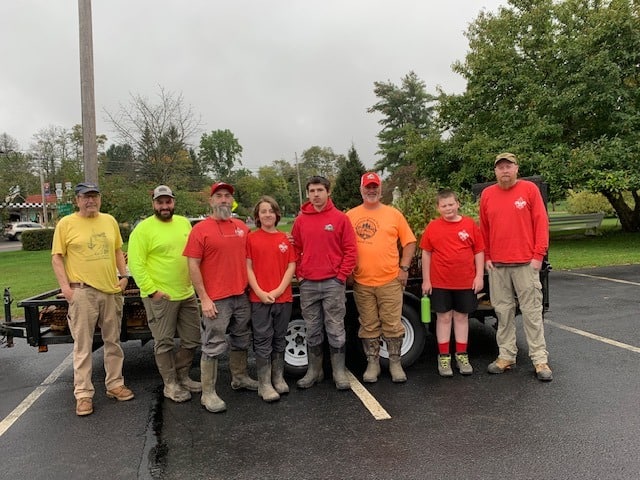

Planting a Riparian Buffer at Mill Creek
posted 10/18/22
On October 8th, BWA with 18 members of Scout Troop 89 and community volunteers planted 150 native trees and shrubs on the streambank of Mill Creek in Mountainhome. The plantings will stabilize the streambank, prevent erosion and help protect water quality in Mill Creek.
The trees and shrubs, along with plant tubes and stakes, came through the Keystone 10 Million Trees Partnership, a state-wide effort to plant 10 million trees and shrubs by 2025.
Native shrubs and trees planted on the stream banks include Silky Dogwood, Gray Dogwood, Sandvar Willow, Black Willow, Eastern Redbud, Hawthorn, Black Chokeberry, Spice Bush, and Swamp White Oak.
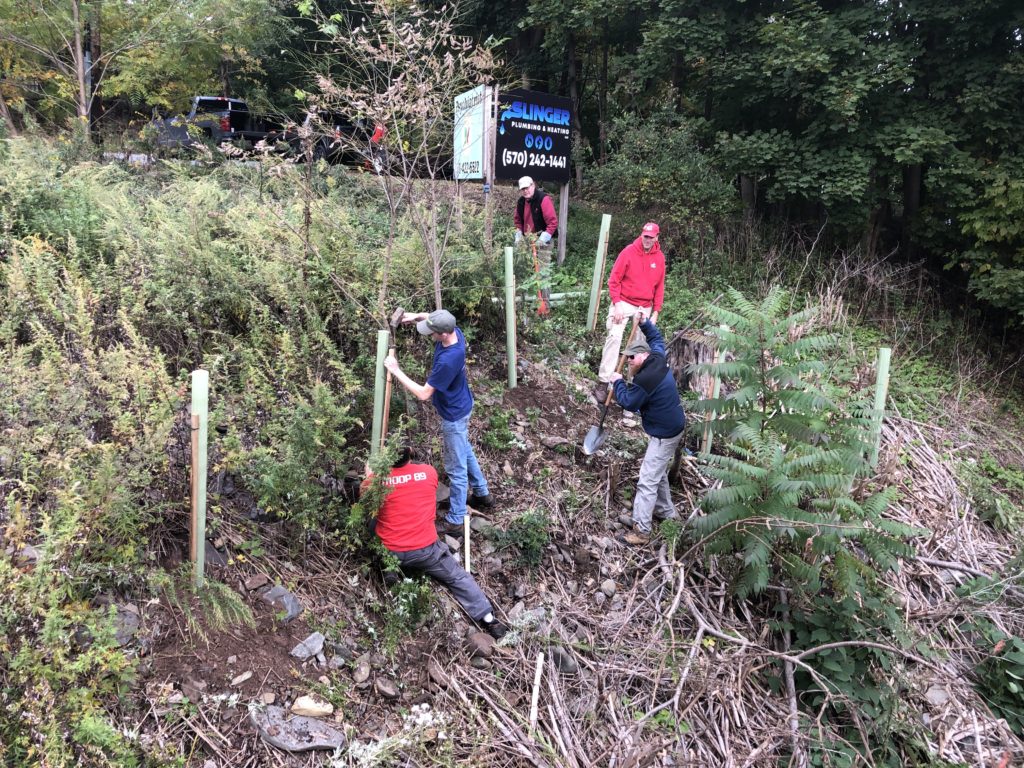
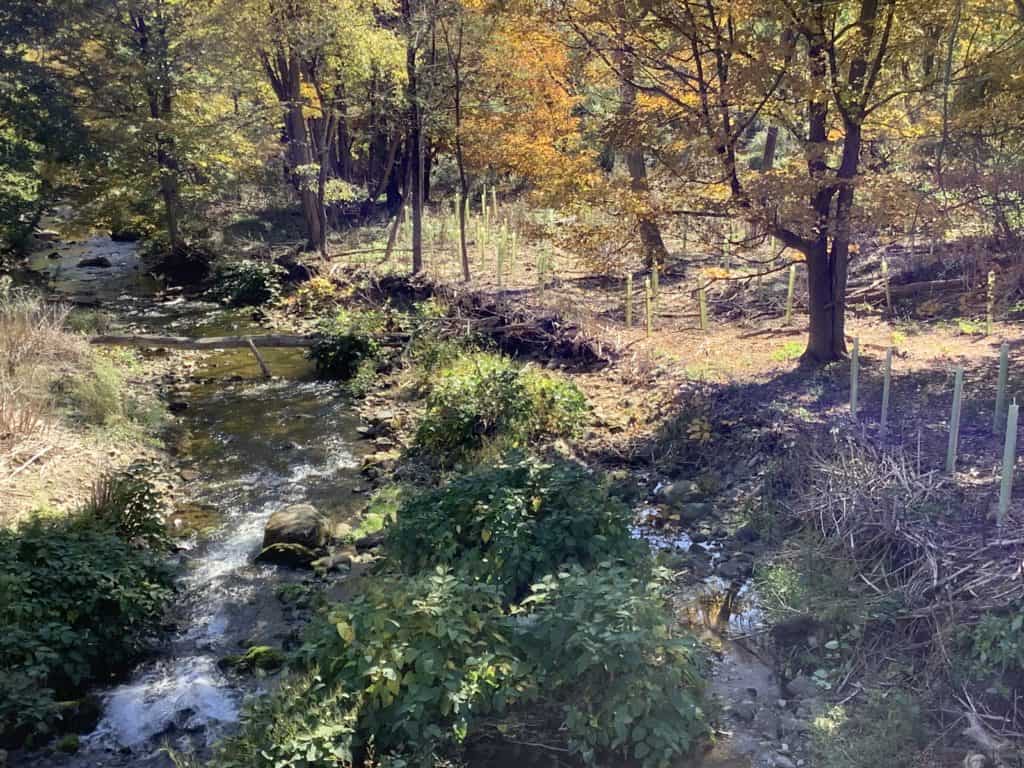
Knocking Out Knotweed — The Last Step
Killing knotweed isn’t easy. But this summer’s demonstration along Mill Creek, in the heart of Mountainhome, proves it can be done.
The fast-growing, aggressive weed crowds out every other living thing, and injures aquatic life in the creek, from bugs to trout. But a three-step process can eradicate it. In late June, the thriving plants were cut to knee-high. Then the plants were allowed to re-grow — using the reserve strength stored in their roots. By August, the regrowth was surging — and looked as if it had never been cut.
Now, licensed pesticide applicators from Strauser Nature’s Helpers have sprayed that regrowth with a herbicide, specially formulated to be safe to use near water. Keep your eye on the knotweed patches near Preacher Hill and the 390 bridge. By the middle of September, almost all of that regrowth will be withering. By first frost, it will be dead.
Since this two-step process forces the plants to use up so much energy, next spring only a very little knotweed will grow. That little new growth will be cut and sprayed again, knocking out the knotweed for good. Then the Boy Scouts will help plant native plants and shrubs here, to restore beautiful Mill Creek to its natural, healthy state!
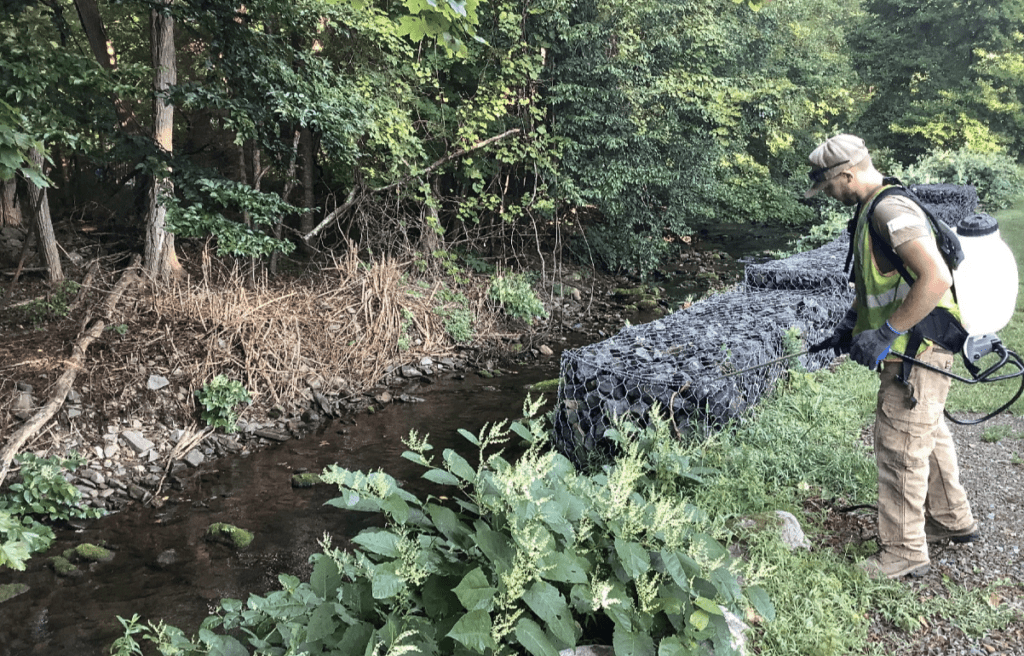
Banishing knotweed from Mill Creek: Persistence is key in battling this pest
Eliminating Japanese knotweed along Mill Creek takes persistence. Brodhead Watershed Association has been working on a three-year demonstration project to eradicate it along streambanks from Route 191 to below Route 390 in Mountainhome, Pa.
The second step for this year is treating with a weedkiller specifically formulated to use close to creeks and streams. Licensed herbicide technicians from partner organization Strauser Nature’s Helpers have recently sprayed the area, carefully using a light spray, just enough to coat the leaves.
“We avoid, whenever possible, using herbicides near streams,” said project manager Edie Stevens. “But sometimes, it’s the only effective way to go. Strauser Nature’s Helpers technicians have extensive training in doing the job safely.”
View the knotweed eradication workshop at facebook.com/strauserlandscapers/videos/531580124848552.

Having been cut this summer, knotweed regrowth at the Route 390 bridge in Mountainhome has sapped the plants’ energy.

A spray technician with BWA partner Strauser Nature’s Helper carefully and lightly sprays the regrowth.
BWA's Report to the Community features Mountainhome
Every day for 30 years, Brodhead Watershed Association has worked to protect our water quality and quantity. Making sure we all have enough pure, safe drinking water is BWA’s mission.
That work involves lots of activities:
• monitoring stream water for pollutants, and taking action when needed to correct problems;
• working to maintain our water’s natural cold temperatures to keep our native trout thriving;
• helping creekside landowners keep water clean and pure by not mowing to the edge of the water and limiting use of pesticides and chemicals;
• and, perhaps most important, raising public awareness that protecting forested land is the best, cheapest, most effective way to protect water.
The centerfold of BWA’s Summer Report to the Community spotlights BWA’s work in Mountainhome, protecting our beautiful Mill Creek.
Neighbors who have taken part include: Troop 89, Mountainhome United Methodist Church, RGM Enterprises, Strauser Nature’s Helpers, Matt Dilger, Trip Dilger, Chadd Gray, Eagle Scout Dillon Brunetti, Darryl Speicher, and Jerry Rinker. The artists who painted the rain barrels included Lee Schuler, Krista Paolucci, Marty Gylleck, Theresa Merli, Jill Swersie, Alexis O’Keefe, Patti O’Keefe, Debbie Hardy, Kristina Closs, Gail Howard, Kristy Galunic, Emilia Kur, Marilyn Derrick, Darryl Speicher, Tanya Lutin, Annelizabeth Messina, Alma Barrantes, Linda Lewis, John James, Cynthia Vineis, Nicole Abrams, Ryan Burke, Kendall Farley, Grant and Madison Hilfiger.
Rain barrel host locations included Mountainhome United Methodist Church, Donaghy Insurance, Callie’s, The Friendly Community Center, NBT Bank, Mountainhome Diner, ESSA Bank & Trust, The Forks Restaurant, Steele’s Hardware, Tom’s County Kitchen, Blake Martin, The Daily Bread, Barrett Township office, Pourhouse/Basso, Capri Pizza, Bloomin’ Onion, Barn Door Antiques, the Michelle Farley law office, and the Hilfiger Contracting office.
Sponsors included Mickey Miller, Donaghy Insurance, Woodfield Manor, Barrett Township Historical Society, Natalie Berdoe, ESSA Bank & Trust, Peter Maier, Steele’s Hardware, Tom’s Country Kitchen, Blake Martin, The Daily Bread, Mick Motors, Rotary Club of the Pocono Mountains, Buck Hill Company, The Pourhouse, Basso Restaurant, Joe and Meg Dilger, Capri Pizza, Bloomin’ Onion, Barn Door Antiques, Michelle Farley, Hilfiger Contracting LLC.
Thank you, one and all!
Now's the time to see if you have knotweed
August 2021
Japanese knotweed is blooming now, usually found near our Pocono creeks and streams, crowding out everything else.
Look for long, arching flower spikes that grow along its branches. The flowers are creamy white, and you may also notice its sticky-sweet scent. It’s much easier to identify now than at any other time of year.
Mark the areas where you find it on your property. Then, mark your calendar for next June, when you can start the two-step process of getting rid of it. Here’s a summary of what you’ll do next year:
In early July, cut all the knotweed down to knee height, NOT shorter.
Over the summer, the knotweed will draw huge amounts of energy from its roots to regrow. In late September, use a herbicide that is safe to use near water on the regrowth.
Within three weeks, most of the regrowth will wither and die.
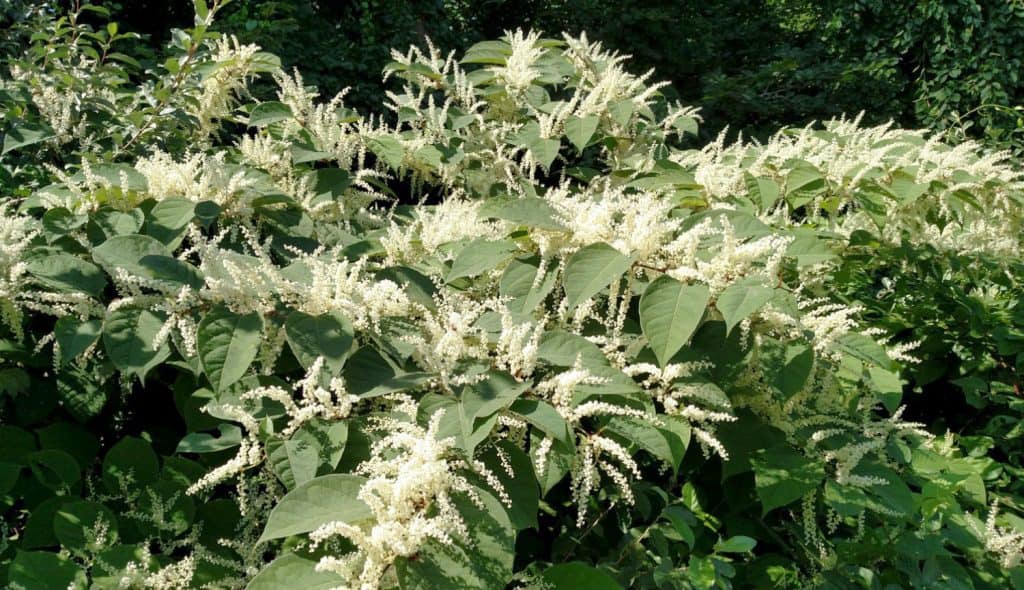
For detailed information on this pest and how to eradicate it, go to https://extension.psu.edu/japanese-knotweed.
What tiny animals can tell us about our watershed
On the surface, it’s easy to see why people say you can’t step in the same stream twice — creek water is always moving, always changing, always different.
But there’s more to it than that. An entire ever-changing world, full of life, exists beneath the surface of creeks.
Trout flit and hover and gape. Leaves and debris fall to the surface, swirl, and sink. Algae and other tiny plants sway in the current. Pebbles, sand, and grit pattern the creek bed.
And then there are the small water-dwellers that make their home here, animals and the larval stage of insects: snails, crayfish, clams and worms, larvae of beetles, dragonfly and stonefly, mayfly and caddisfly.
Collectively, these critters are called aquatic “macroinvertebrates” — the 50-cent word for creatures that don’t have a backbone and are large enough to see with the naked eye.
Most live attached to submerged rocks, logs, and vegetation. Most are tiny. Yet they play a huge role in the health of every creek, including Mill Creek, which runs through the heart of Mountainhome, Pa.
They are the base of the food chain, a main food source for fish, birds, reptiles, frogs and other amphibians. Just as important, macroinvertebrates shred and break down plant material that grows in or falls into the water — making it available as another food source to larger creatures.
And they tell us a lot about the health of the creek where they live.
Certain kinds of macroinvertebrates can’t live in polluted waters. So scientists studying creek health spend a lot of time turning over creek rocks in early spring.
If they don’t find caddisfly, stonefly or mayfly larva, chances are there’s a problem.
People who fish for trout know and study these tiny creatures and try to “match the hatch” when choosing lures that will best attract a fish. There’s a reason trout lures are called “flies”!
For an elegant, easy-to-use chart and information on these fascinating creatures, go to www.macroinvertebrates.org. And if you like puttering around in the water, a hands-on, in-creek event is being planned by Pocono Heritage Land Trust to help you uncover, identify and learn about macroinvertebrates. A local naturalist will lead the program, which is in partnership with the Sierra Club and Brodhead Watershed Association. For information, stay tuned to www.phlt.org, or call 570-424-1514.
The Greening Mountainhome project is a Green Communities project funded by grants from the National Fish and Wildlife Foundation, with support from The William Penn Foundation and the Weiler Family Foundation.

July workshop: Controlling knotweed along creeks
Brodhead Watershed Association will host a workshop in July, part of the Greening Mountainhome Series, on how to control knotweed along creeks — and in your backyard.
In 2020, volunteers cut knotweed along Mill Creek in Mountainhome, Pa., and treated the invasive with herbicide. Uncontrolled, the non-native plant spreads quickly and chokes out other plants.
The treatment worked. In 2021, there is hardly a wisp of knotweed to be seen.
That demonstration project covered just a small area. Now, knowing that this process actually works, it’s time to put the process into action.
Register for a live, on-stream workshop led by Robin Anglemyer. Learn the right time to cut knotweed, what tools you need, how low to cut it (hint: ankle height is too low!), and what to do next. The tentative date is Wednesday, July 7, at 4 p.m. — but exact timing of the workshop will depend on weather conditions and knotweed growth. REGISTRATION IS NOW CLOSED.
On the day of the event, workers from Strauser Nature’s Helpers will clear knotweed along Mill Creek in Mountainhome from Route 191 to Route 390 to Wieboldt Road — keep an eye out!
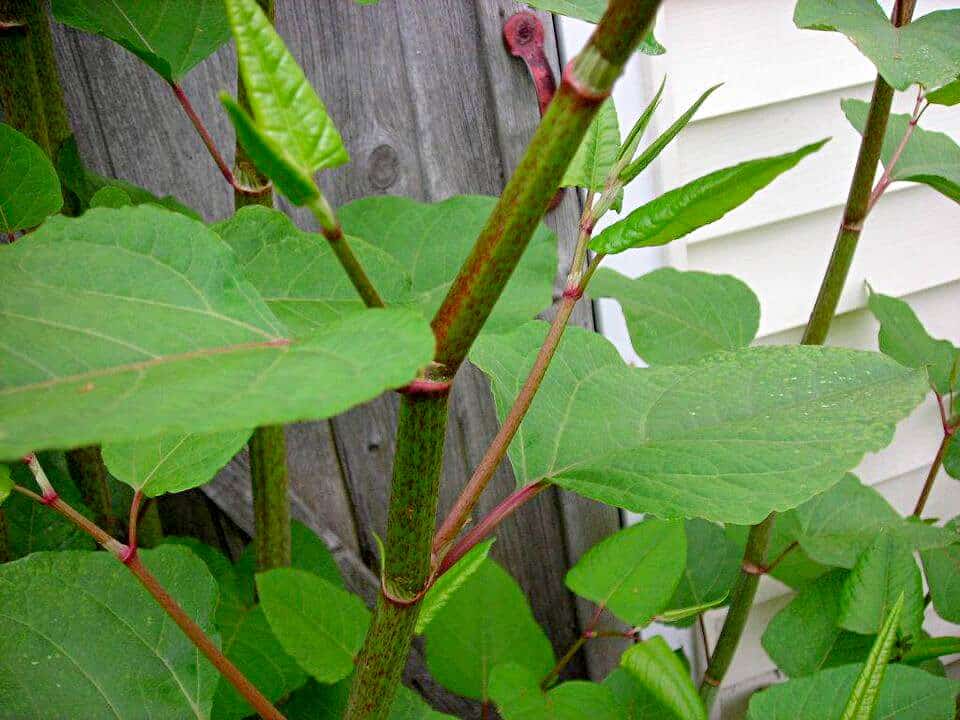
In June and July, look for the bamboo-like stems of Japanese knotweed along creeks. This invasive weed crowds out native plants that support healthy creeks and streams, native trout, birds and other creatures.
24-7 testing at Mill Creek
We’ve all learned much more than we ever expected to about the “cold chain” — keeping coronavirus vaccines super-cold through many stages of shipping.
How do shippers know for sure that the right temperature stays steady?
They use sensors, called data loggers, to keep track round-the-clock.
Data loggers can electronically monitor all kinds of variables — not just temperature but also wind speed or direction, vibration, almost anything that can be measured. And they can monitor data in almost limitless settings, from what’s happening in volcanoes or earthquake zones to what’s happening in a creek.
In fact, as part of the work of Brodhead Watershed Association’s Greening Mountainhome project, volunteers Matt Dilger and Michael Johnson have set up a data logger in Mill Creek.
Like the “cold chain” monitors, the Mill Creek logger keeps track of temperature. It also tracks the depth of the water. Because even on hot summer days, healthy creek water stays cool, the way trout like it. And even when it hasn’t rained for a while and creeks are low, cool groundwater keeps the creek flowing and habitable for trout and other creek critters.
The data logger also keeps track of something called “electrical conductivity.” Conductivity measures water’s ability to carry electrical current based on the concentration of ions in the water. In Pocono streams, most conductivity comes from salt that’s washed off roads and parking lots.
Even salt that filters into the ground eventually reaches streams. In areas near interstates and other busy highways, salt levels are so built up in groundwater that conductivity remains high throughout summer.
Fortunately, our area’s headwater streams, including Mill Creek in the Upper Brodhead watershed, look good. Keeping them that way is the point of the data logger.
You can see data loggers throughout the Brodhead Watershed at monitormywatershed.org. Search for “Brodhead” for sites maintained by BWA and “East Stroudsburg” for sites maintained by ESU.

This equipment is connected to the data logger in the creek and communicates the data that is being recorded every five minutes.
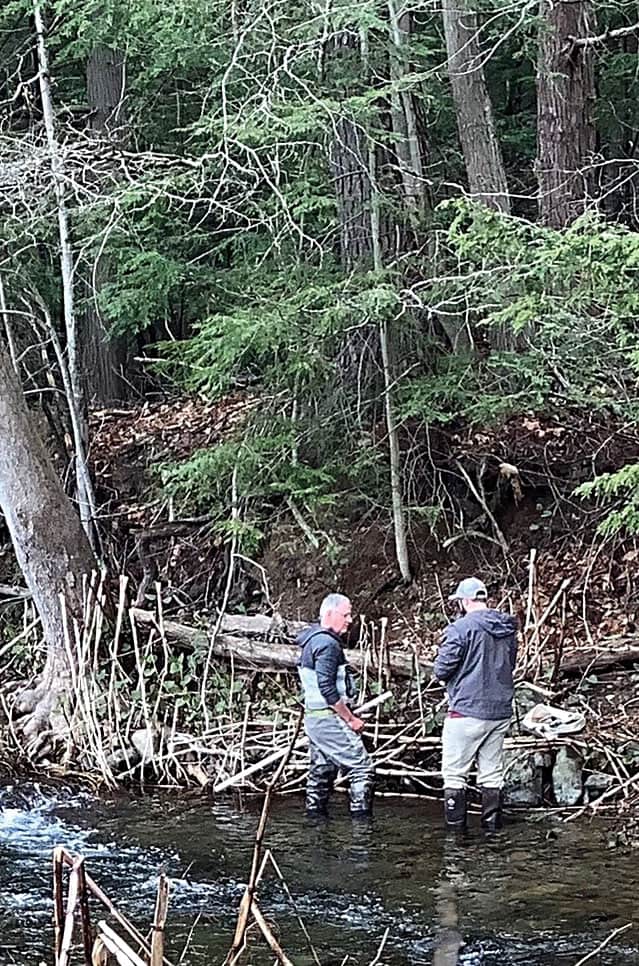
Volunteers Michael Johnson (left) and Matt Dilger start the process of installing the data logger in Mill Creek.
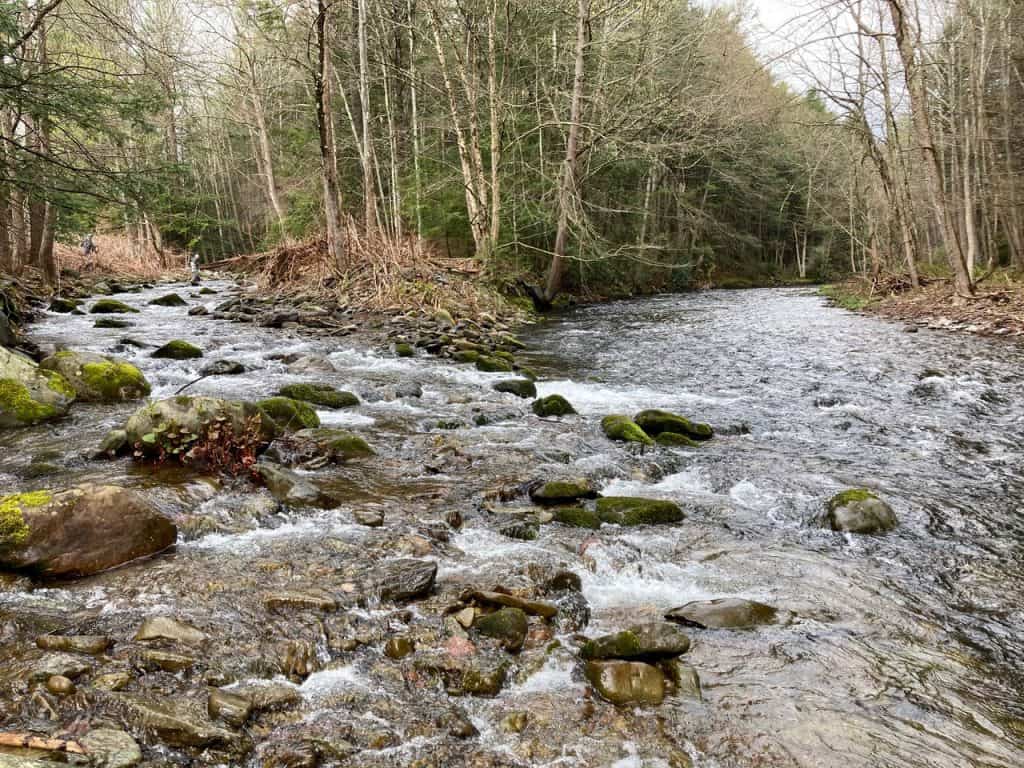
The confluence of Mill Creek (left) and Brodhead Creek.
“Essential services” courtesy of PA Game Commission — and Mother Nature
Even if you don’t hike, hunt, or spend any time at all in nature, the forests of Pennsylvania serve you in ways that make life better.
Views, for starters. Just seeing green views enhances mood, reduces blood pressure, and counteracts stress. All around Barrett and Paradise townships, unspoiled land protected by the Pennsylvania Game Commission and others unrolls in every direction. No depressing McMansions. No cookie-cutter developments. Just open sky-scapes and the seasons unfolding around you as you go about your business.
Safe drinking water, too. In the process of managing forests to improve wildlife habitat, the Game Commission keeps woodlands healthy. And healthy woodlands are the first, best defense of drinking water. As rain and snowmelt percolate through the soil, contaminants get filtered out before the water reaches Tank Creek, Devil’s Hole, and Mill Creek — or your well. People around the country have to pay for water that’s treated to make it drinkable. Here, preserved land supplies it to us naturally.
Even the air is cleaner in forestland. When noxious stuff like ammonia or sulfur dioxide settles on the leaves of a tree, the tree actually absorbs the toxic chemicals — scrubbing air clean for you and your family to breathe. Trees capture particulate matter, too — the sooty grunge that settles on windowsills in cities — which clogs the air and leads to heart and lung disease.
If those aren’t enough gifts from the forest for you, here are some more: Trees absorb the carbon dioxide we breathe out and release the oxygen we breathe in. They store climate-changing carbon in their wood. They’re big-time recyclers, soaking up water from the earth and releasing it from their leaves, to fall back to earth as purified rain. And their roots hold soil in place, preventing erosion.
So when the Game Commission works to keep habitat in State Game Lands 221 hospitable for game birds, deer, and bear, they’re protecting air, water, and hospitable habitat for all kinds of nature’s creatures. Including us.

The forest helps keep our water clean, naturally.
ENJOY THE GAME LANDS: Game lands are open to the public. Whether hunting or hiking, always wear orange — something is almost always in season. Trailheads for Pennsylvania State Game Lands 221 are at the end of Pleasant Ridge Road in Mountainhome, along Hardytown Road in Cresco, and off Devil’s Hole Road in Paradise. A map of State Game Lands 221 is here.
Half a mile of knotweed gone; preparing for more in summer 2021
Landowners along a half-mile stretch of Mill Creek in the heart of Mountainhome can get help controlling the knotweed which clogs their banks and the creek, starting this summer.
Brodhead Watershed Association sent letters to streamside landowners in early February, describing the work, which will start in late June/early July. Participation is voluntary. The treatment is free to the landowner, thanks to a grant from the National Fish and Wildlife Foundation, managed by BWA.
Knotweed may seem like nothing special, but it can make a mess of a creek.
Some of the damage is obvious. Knotweed is a fast, vigorous grower, and established stands can completely engulf a small stream like Mill Creek, interrupting water flow, eroding banks, and even changing the water’s chemistry. Native plants get completely crowded out, and all that knotweed debris ends up in the creek in the fall, smothering everything.
The stretch of bank to be treated starts where the creek goes under Route 191, paralleling Brutzman Extension for 1,500 feet to Route 390, then another 1,200 feet to Wieboldt Road. The procedure recommended by Penn State will be followed: cutting in late June/early July and then treatment with herbicide by a licensed operator in late September. The herbicide is specifically chosen to be safe around water, and the licensed operator is Strauser Nature’s Helpers.
On one property, a second control method called “cut and cover” will be used. The knotweed will be cut in June, and then covered with landscape fabric to prevent regrowth. This will allow comparison to determine the most effective procedure.
Knotweed is persistent, and the funding for the project includes treating the area again in 2022.
Last summer, a 500-foot “demonstration area” was treated from Route 191 to Pleasant Ridge Road. Any regrowth this year will be treated again by volunteers Trip and Matt Dilger.
“Getting rid of knotweed here in summer prevents it from setting seed,” said Edie Stevens, who is managing the project for BWA. “That keeps seeds from moving downstream — so this project also protects lower reaches of Mill Creek as it heads toward the Brodhead.”

HOW INVASIVE KNOTWEED SABOTAGES TROUT
Removing knotweed once it is established is painstaking, slow work. Locally, Buck Hill Falls has undertaken a large project to remove it in the upper reaches of Buck Hill Creek. The work has been successful, but it’s taken three years. And vigilance will be required to treat and remove new growth.
Why is it worth the effort?
In addition to the obvious damage knotweed does by clogging creeks, a lot happens below the surface.
Native trout feed on a smorgasbord of macro invertebrates — the critters that live in and on the bed of a healthy, cold creek, like dragonfly and stonefly larvae, tiny snails, worms, and beetles.
Macroinvertebrates in turn feed on decomposing leaves. But not just any leaves — they feed on decomposing leaves of maple, oak, and other native species. Knotweed debris is just so much garbage for them, no more useful as food than pebbles, dirt or grass would be to a human.
So when knotweed takes over a stream, macro invertebrates suffer and decline, leaving trout reduced sources of food. And it’s a one-two punch for the fish. Since knotweed leaves don’t get broken down, they settle on the creek bed, fouling the clean gravel trout need to spawn.
Nature is a balancing act. When we throw a wrench in the works with an invasive like knotweed (which was intentionally introduced as an “ornamental” in the late 1800s), it’s on us to try to fix it.
For information on knotweed, click here.
Knocking out knotweed along Mill Creek in Mountainhome
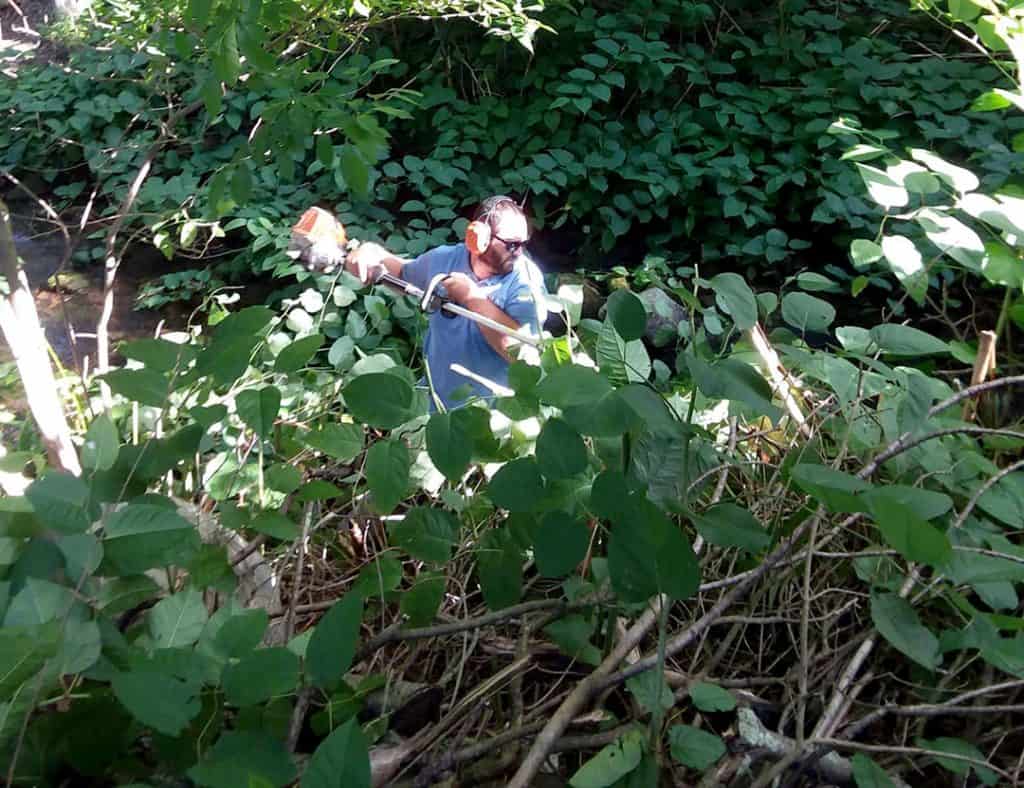
Matt Dilger chops down knotweed along Mill Creek.
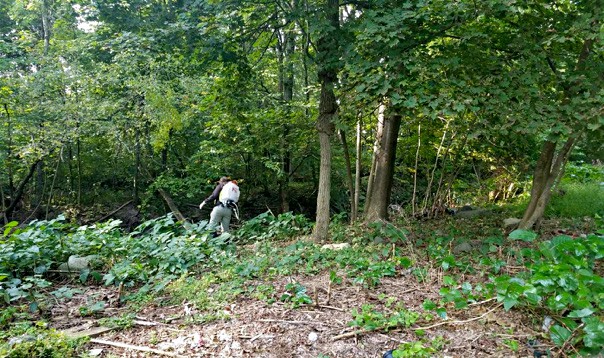
The patch of knotweed has regrown after being cut and must be treated.
By Carol Hillestad
Knotweed clogs creeks almost everywhere in Monroe County, and Mountainhome’s Mill Creek in Barrett Township is no exception. A project to demonstrate how it can be eradicated is underway there with help from Brodhead Watershed Association.
This invasive weed crowds out native plants and fills the creek with debris, harms our own native fish and plant life, and spreads like crazy. It can alter life and water conditions in our natural creeks.
But it’s not indestructible.
HOW TO CONTROL KNOTWEED
In early July 2020, BWA started a three-year demonstration project of how to control this pest. In one week, they worked both banks along a 500-foot stretch of Mill Creek, starting at the Forest Fire Crew Station on Route 191 and then upstream to Monomonock Road. They cut all the knotweed down to knee height, NOT shorter.
Over the summer, the knotweed drew huge amounts of energy from its roots to regrow. In late September, a licensed applicator from Strauser Nature’s Helpers treated the regrowth with an herbicide licensed to use near water. Within three weeks, most of the regrowth had died (while other stands downstream were still green and healthy).
A THREE-YEAR PROJECT
This is the first year of a three-year demonstration project. This stretch will be examined for regrowth next June. If there is any, it will be cut, again knee-high, and the regrowth will be treated in the fall. The same process will be followed the third year.
This cycle of forcing the plant to use all its energy in regrowing again and again finally exhausts it.
Once the knotweed has stopped regrowing, streamside plantings of native plants can be done to replace it.
This technique of cutting to knee height, then treating regrowth in late September, is endorsed by Penn State University after years of research. It was used by Certified Forester Barry Rose on Buck Hill Creek, with 98% success. However, to be effective, control must start at the furthermost upstream “seed bed” of knotweed, or the upstream patches will continue to bring seeds and stalks downstream.
It’s important to note that this demonstration project covers a short stretch of stream. Much more needs to be done to make an impact on knotweed throughout the watershed.
For information: https://extension.psu.edu/japanese-knotweed
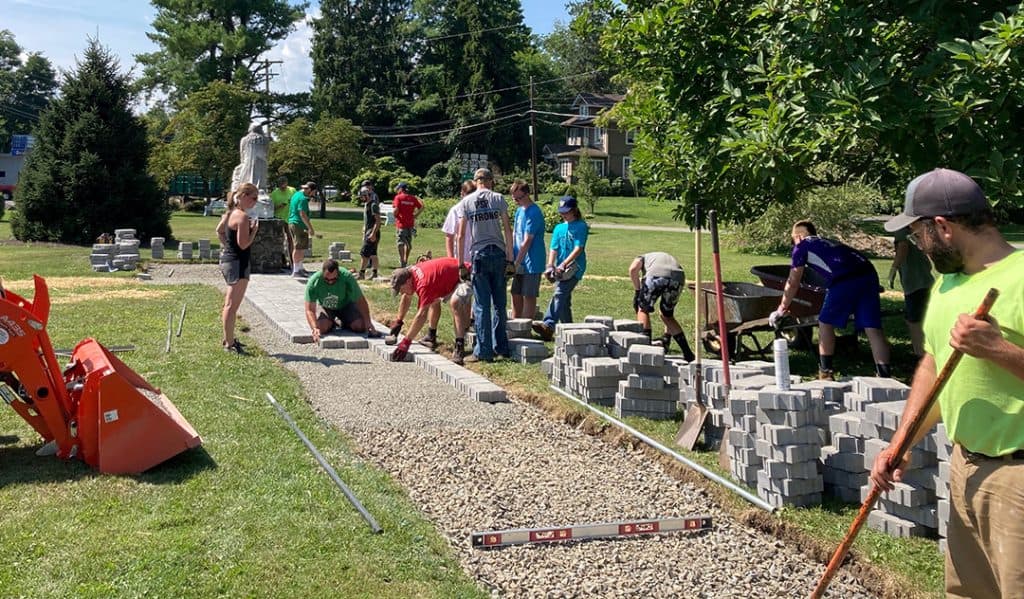

Mountainhome church digs in to protect Mill Creek
August 2020
By Carol Hillestad
For Brodhead Watershed Association
Mill Creek is one of the cleanest, purest waterways in Monroe County, according to a 2019 study.
Keeping it that way is the goal of an Eagle Scout project and a stormwater infiltration project at Mountainhome United Methodist Church.
“Mill Creek is directly downhill from the church. The church roof, asphalt parking lots and an asphalt walkway were funneling dirty stormwater right into the creek,” said Edith Stevens of Brodhead Watershed Association, which helped coordinate the projects. According to Stevens, “Millard Price, Mickey Miller, Chadd Gray and Trip Dilger, all members of the local community, worked with us to make sure the projects were the right fit for the church.”
Miller, a longtime member of the church, said, “I worried about the mess and how everything would look when they were done. But the pavers are beautiful, and they did a beautiful job cleaning up after the work was done. And once the grass starts to grow, you won’t even know where the underground trench is.”
For his Eagle Scout project, Dillon Brunetti of Canadensis replaced the impervious asphalt walkway with pervious pavers, which allow rainwater to sink into the ground. Brunetti worked with fellow Scouts from Troop 89 and neighbors to get the old asphalt removed and new paving stones set in place to allow rain from heavy storms to infiltrate slowly.
Matt Dilger, Chadd Gray, Dave Ohmnacht, Ralph Megliola, and Trip Dilger helped get the work done along with many others. Brunetti raised money in the community, including from Brodhead Watershed Association, for the project. BWA paid for the paving stones and RGM Landscaping did the preliminary work to remove the walkway.
Jerry Rinker, a local businessman who has been in the excavation business for 32 years, won the contract to build an underground stormwater infiltration trench.
“The trench is basically an underground void that releases stormwater into the earth slowly,” he said. “It’s lined with geocloth and holds two pipes, 80 feet long and two feet in diameter, that have small holes that will hold rainwater draining from the parking lot and allow it to seep out slowly into the earth.” The pipes are surrounded by crushed stone, and finally covered with a layer of soil and grass.
In all, 209 hours of work were donated by the Scouts and the community. The Barry Quarry donated the stone, and hauling was donated by Haab Trucking.
The infiltration trench was designed by Drew Wagner, engineer with Monroe County Conservation District. Funding for the project came from a National Fish and Wildlife Foundation grant for green projects to protect Mill Creek, administered by Brodhead Watershed Association.
Look for signs of greening in Mountainhome
When rain falls or snow melts in a natural landscape, the water slowly seeps into the earth. But parking lots, roads, roofs, and other hard surfaces interrupt that natural cycle. Instead of seeping into the earth, stormwater rushes off and scours away, washing sediment and other pollutants into the nearest creek.
“Green infrastructure” is an umbrella term for the many ways it’s possible to slow that stormwater down, capture it, and allow it to seep into the soil in ways that mimic nature.
That’s what the flurry of activity this summer was all about at Mountainhome United Methodist Church, on Route 390 in Mountainhome, Pa., where two green infrastructure projects were installed. One involved removing solid asphalt and replacing it with pavers that allow stormwater to sink deep into the ground. The other created an underground holding tank that captures stormwater runoff from the church roof and parking lot, allowing it to infiltrate the soil slowly and naturally.
Mickey Miller, a long-time member and leader of the church, was pleasantly surprised by the results. “I was afraid it was just going to be such a mess,” he said. “But now you can’t even tell where the work was done.”
That’s a good thing. But part of the purpose of the projects was to clue people in on how green infrastructure can purify water and protect beautiful Mill Creek, the heart of Mountainhome.
“Signs will be posted here in the spring,” said Edie Stevens of Brodhead Watershed Association, who got the project rolling. “One shows a cut-away view of the underground trench. The other shows the permeable layers that are underneath the new pervious pavers.” The interpretive signs will have photos and information about how the projects work.
“Compared to the cost of cleaning up a polluted stream, green infrastructure is a bargain,” Stevens added. “It’s natural, cheap, and much more effective than complicated mechanical systems.”
The Greening Mountainhome project is a Green Communities project funded by grants from the National Fish and Wildlife Foundation, with support from The William Penn Foundation, and the Weiler Family Foundation.
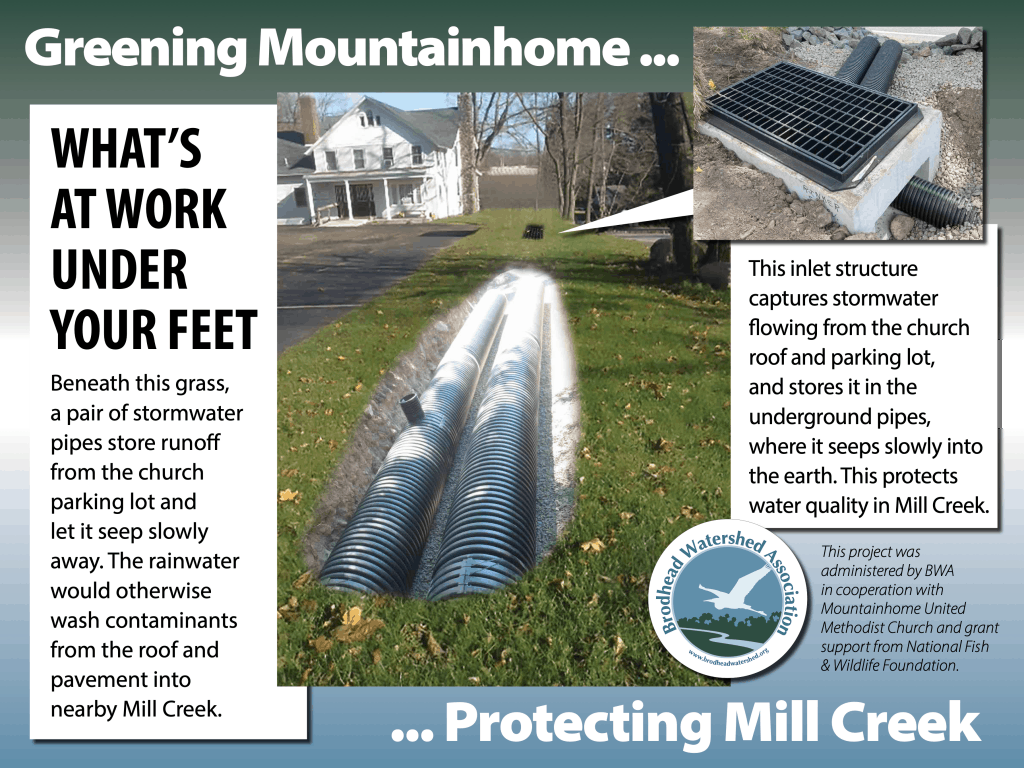

GO GREEN AT HOME WORKSHOPS
JULY 2020 WEBINAR: Rain barrels – why and how to use them
Have you ever wished for a more efficient way to water your garden, keep your car clean and save money all while helping the environment? A rain barrel can do all this and more.
On July 25, 2020, Brodhead Watershed Association, in partnership with Monroe County Conservation District, hosted a webinar showing what rain barrels do, how to install one and to decorate it.
In this online workshop, part of BWA’s Greening Mountainhome program, Darryl Speicher talked about this method of collecting rainwater for many uses around the house as well as its pollution prevention abilities. Here is an archived recording of the webinar:
In May 2020, the webinar Garden for Clean Water was held.
Local Master Gardener Amy Romanelli-Girardi led the webinar on how to keep your water clean and the garden growing all summer long.
“What we put in our garden affects more than just our garden,” Romanelli-Girardi said.
Learn how your choice of plants can directly and indirectly contribute to water quality, how home landscapes impact the entire area drained by Brodhead Creek, and which native plants work for yourself, wildlife, and everyone’s drinking water.
To see the archived webinar and learn more about native plants, click here.

PROJECT: Barrels around Barrett

In another facet of the Greening Mountainhome program, beautifully painted rain barrels have been installed in Mountainhome.
Looking for the barrels? Check the map here.
Painted rain barrels beautify their locations as well as catch roof runoff to be used in gardens nearby.
Thank you to these barrel artists: Krista Paolucci, Marty Gylleck, Theresa Merli, Jill Swersie, Alexis O’Keefe, Patti O’Keefe, Debbie Hardy, Kristina Closs, Gail Howard, Kristy Galunic, Emilia Kur, Marilyn Detrick, Darryl Speicher, Tanya Lutin, Annelizabeth Messina, Lee Schuler, Alma Barrantes, Linda Lewis, John James, Chelsea Mayo with Cynthia Vineis, Nicole Abrams, Ryan Burke, Kendall Farley, Grant & Madison Hilfiger.
Sponsors include: Bloomin’ Onion Restaurant; Michelle Farley; Joseph Dilger, DDS; ESSA Bank & Trust; NBT Bank; Blake Martin Financial; Donaghy Insurance; Steele’s Hardware; Capri Pizza; Mick Motors; Woodfield Manor; Frogtown Chophouse; Buck Hill Falls Company; PourHouse; Basso; Rotary of the Pocono Mountains; Barrett Township Historical Society; Tom’s Country Kitchen; Callie’s Candy Kitchen; Daily Bread; Barn Door Antiques; Mickey Miller; Peter Maier; Natalie Berdoe; and Hilfiger Contracting LLC.
For more information about installing and maintaining rain barrels, click here.

